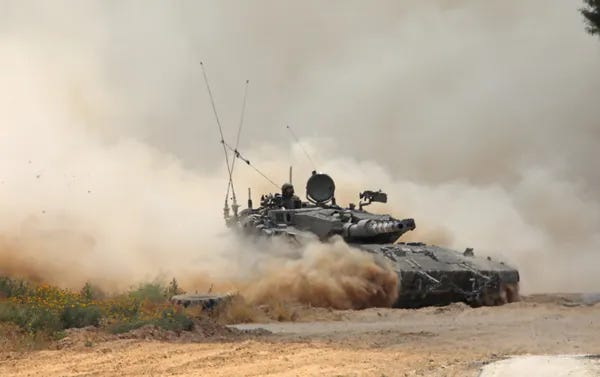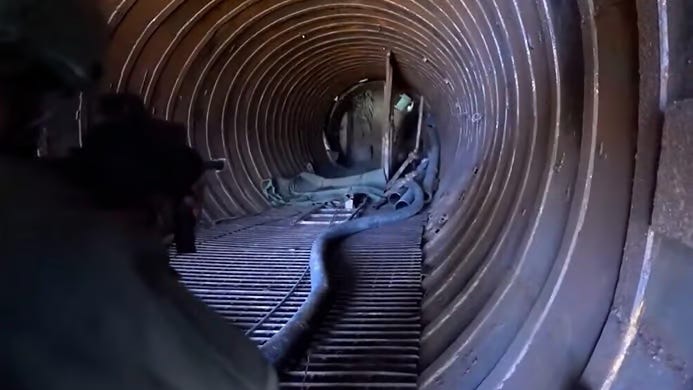On Monday night at least two Brigades from the 162nd “Ha-Plada” Division seized the Rafah border crossing, sealing off the border between Gaza and Egypt. This was not the long-awaited ground invasion, but a limited operation designed to give the Israeli cabinet options for the next phase.
Understanding this operation means understanding the mosaic of constraints – political, diplomatic, and military – that shape how it unfolds. Incidentally, my use of the term ‘constraint’ here is not intended to be negative – quite the opposite.
The United States opposes any major operation in Rafah out of concern that it will lead to heavy civilian casualties in the densely populated area. Egyptian officials oppose a direct assault on Rafah from fear that Hamas might try to destroy part of the fence to help large numbers of Gazans to flee into Egypt.
Because of these objections, Israel has agreed to restrict its operation in Rafah, which started on Monday, focusing only on the eastern side of the city and the border crossing that connects Gaza with Egypt.
Military Goals
From the perspective of the IDF, going into the city of Rafah makes operational sense since doing this would enable them to clear and seal the tunnels that are Hamas’s main channel to the outside world. Seizing the crossing goes partway at least towards achieving this objective and was something that could be done rapidly and decisively – more in line with the IDF’s concept of warfighting than the slow, attritional slog that characterized their advance into Gaza City and Khan Yunis.
Leaving aside the tunnels, Hamas' loss of control over the Rafah crossing would be a significant setback for the group. It will not be able to collect taxes imposed on trucks and goods and will no longer be able to bring in weapons and other items banned from entering Gaza.
What Next?
Once the crossing is secured by the IDF, it controls around a third of the Philadelphi Corridor, the route along the border between Gaza and Egypt. But beneath the remaining two-thirds of the corridor, right up to the waters of the Mediterranean, lie more tunnels. And to the east, in the city itself, sits Hamas’s Rafah Brigade – at least four battalions of fighters by the most conservative estimates. The IDF will have to deal with both of these threats in order to declare victory. And to remain static puts the forces in a vulnerable position – as was the lesson from Sunday’s deadly rocket attack on an IDF assembly area near the crossing at Kerem Shalom.
The Rafah crossing is one of the two main entrances for humanitarian aid (along with Kerem Shalom which is closed since Sunday’s attack). The IDF doesn’t want to get stuck operating it – it would be all risk with no gain for them. Neither – for the same reason – do the Egyptians. So they plan to turn crossing operations over to an unnamed US security company. Such a company will require security guarantees from the IDF: surveillance and fires overwatch and a designated reaction force at a minimum. The IDF may think that they are done with Rafah crossing, but Rafah crossing – as the saying goes….
Where the IDF goes next is, of course, up to the politicians – but the units on the ground offer some clues. For one, they are all regular formations, which means that the IDF is prepared for a longer stay this time, and second, they comprise a large contingent of combat engineers, which suggests tunnel clearing.
Significant by their absence are the IDF’s special operations forces (SOF). Five SOF units have been involved in the campaign so far – usually spearheading the advance – and for now the plan is for them to do all the fighting in Rafah. While conventional forces hold down objectives outside the city and above ground, their SOF counterparts will be operating inside the city and beneath it – in the tunnels beneath the Philadelphi corridor. Since 7 October, SOF have suffered a casualty rate far higher than the rest of the IDF – enough to cause concern for the general staff. Now these units are either in Rafah already, preparing to go, or reconstituting.
Can a deal be reached?
The war cabinet has sent to Cairo a low-level delegation not the A-Team of former senior Shin Bet security service and Mossad chiefs that represented Israel to this point. Netanyahu's position remains that Hamas response to the Egyptian proposal includes demands that Israel cannot agree to.
Reaching a deal depends on the mediators being able to tone down Hamas' demands enough to force Netanyahu to send the senior team to discuss the full implementation and then present the deal to the cabinet. Even if Netanyahu can overcome these obstacles he will have to sell the deal to his right wing partners. That’s not going to be easy.
Biden or Ben-Gvir
If Netanyahu ends the talks the next step will have to be expanding the campaign in Rafah to the city itself. This is where Israel may finally cross the Biden administration's red line. This is the dilemma Netanyahu has been trying to put off – where he has to choose between his geo-political and political allies. Which is why the talks in Cairo are unlikely to end soon.
What this Means for the IDF
The IDF will have planned for this political constraint - a delay between phases of operation - by keeping Hamas units in Rafah on the back foot, while sealing their access to the outside world. However, such operations require heavy emphasis on special operations forces and engineers - two areas in which the IDF already faces critical personnel shortfalls. Conventional forces positioned around Rafah are also vulnerable to attack — increasingly so, the longer they remain in place. For all these reasons, IDF Chief of Staff Major General Herzi Halevi will be under increasing pressure from his commanders to push for a decision from the Prime Minister. Getting that decision may be almost as much of a challenge as the operation itself.




Andy, I learned more about the tactical (and some strategic) situation from this post than I have from reading from the WSJ and NYT. I'm glad you are reporting the fight.
Andy, once again thank you for helping me to understand.